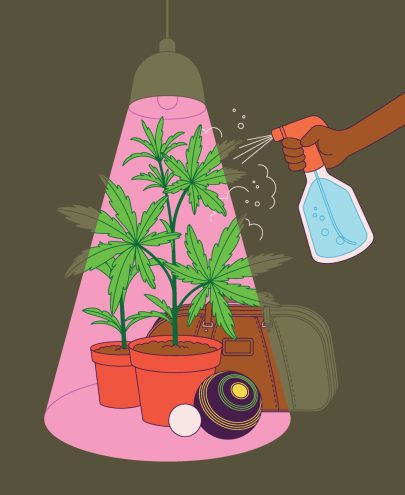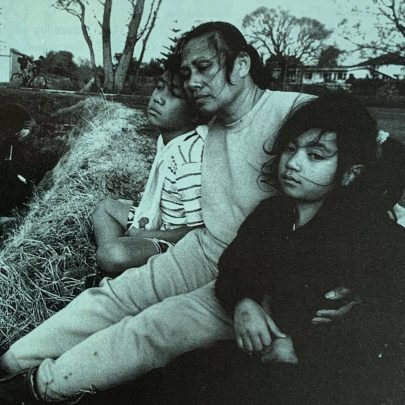Nov 19, 2013 Crime
First published in Metro, March 2011.
The midnight blue kimono she’d won selling Avon is crumpled next to the stereo on the floor. A pace away, by her foot, are her black underpants, rolled up and seemingly kicked off. Under her right shoulder, her pretty peach satin and black lace chemise is darkened with her blood.
By her left elbow is the stainless-steel kitchen knife that has been used to stab her so hard through the chest that it’s bruised her back.
It’s as if her killer has ordered her to discard each item of clothing in turn in a chilling advance towards the single bed in the corner of the lounge where her body now lies, face down and naked on the patterned brown carpet.
Her head is under the bed, partly covered by the sheets she may have pulled towards her in her death throes. Her left foot perches awkwardly on a mattress she’s made up on the floor for when her grandchildren stay.
Her eyes are blackened and runnels of blood have trickled from her breast to her back. Blood is smeared on the backs of her thighs and the soles of her feet but there are no defence wounds.
Chattrice Maihi-Carroll, 46, lived and died in Cottrell Cres, Napier, just one street away from the homes of 1980s murder victims Teresa Cormack and Kirsa Jensen. In December, five-year-old Sahara Baker-Koro died in Riverbend Rd, just around the corner. But Maihi-Carroll’s killing one weekend in January 2008 was never going to stir the country’s passion the way those did. Outside of the police, her family and friends, few of us cared about her ordinary life and violent death.
Today, the police file on Maihi-Carroll’s murder remains open, but no one is assigned to the investigation. The case against the man charged with her killing, her neighbour Zion King, was thrown out of court in February last year when prosecutors agreed a conviction based on their evidence may be unsafe.
Not a single forensic test linked King to the crime despite months of painstaking scientific work which turned up a wealth of ultimately useless DNA findings — indicating, perhaps, that the increasing sophistication and sensitivity of the technology can sometimes hinder investigations more than help them. The prosecution relied on only circumstantial evidence — what King may have said when, and to whom.
It’s clear police still privately believe he is their man, despite their case being so flimsy it didn’t even get to a jury. King says the officer in charge told him so when he went to collect his belongings from the Napier police station. “It’s you,” Detective Sergeant Tim Smith said. “You did it.”
But in this classic suburban whodunit, the only certainty is doubt.
When Chattrice Maihi-Carroll’s body was found by worried relatives around 36 hours after her death, police didn’t have to look far afield to find a couple of prime suspects — neighbours in the block of four Housing Corporation flats in Onekawa.
On one side was her friend Eddie Nathan, then 61, and Nathan’s 39-year-old son Michael, a heavily tattooed former Mongrel Mob associate on home detention for burglary.
On the other was cleaner Zion King, 43, also a former Mob associate, who’d moved in just before Christmas and met Maihi-Carroll for the first time only a few days before her death.
Police described Chattrice Maihi-Carroll, an epileptic and sickness beneficiary, as a “low-risk victim”.
But she was more than that. A loving mum, house-proud, an excellent cook, a careful budgeter, always neatly turned out. The crime-scene photographs depict strikingly the incongruity of the random violence against the orderliness of her home. Beds are made, clothes are folded, dinner dishes are washed and draining on the sink, crockery, pans, cutlery all neatly stored.
But like all of us, no matter how hygienic our habits, Maihi-Carroll lived in a veritable soup of DNA — scientists examined more than 150 samples from her home and those of her neighbours.
One problem with DNA testing is that some tests can now detect such tiny amounts of DNA it may be dangerous to draw conclusions about its relevance. Even tests with the highest sensitivity, for example, can’t tell us which cells the DNA came from: DNA taken from a couch, for example, could be semen from an attacker or dandruff transferred when the victim sat next to someone on a bus.
In this murder, many findings led investigators down tantalising but ultimately blind trails. The first was the bloodied carpet on which her body lay, which revealed full DNA profiles from two semen stains. One of these excited hopes of an early breakthrough when it returned a “hit” on the national DNA databank, until the match proved to be that of prolific Hawke’s Bay paedophile Barry Taukamo. The problem was that Taukamo was sentenced to preventive detention in 2000 and remains in jail. He was not Maihi-Carroll’s killer, but a previous tenant of her flat. The other semen, police speculate, may have come from one of his many victims.
The murder weapon yields nothing (unlike glass, stainless steel isn’t a good surface for retaining DNA, apparently) and neither does the knife drawer in Maihi-Carroll’s kitchen from where it came.
It means scientists could find unequivocal DNA evidence of a man who lived in the flat eight years previously, but no sign of the killer who had executed Maihi-Carroll just two days before — despite the murder being a particularly grisly one. It was her injuries and the patterns of blood on the carpet and hearth that gave forensic examiners clues to the last, appalling minutes of her life. Investigators believe she was knocked out, stabbed six times while prone, then somehow regained consciousness and sat up, or even crawled a short distance, before succumbing to her wounds.
There is no sign of forced entry. Maihi-Carroll was highly security conscious, suggesting she knew her killer and invited him in.
Eddie Nathan’s house, as well as Zion King’s, is painstakingly combed. Eddie and Michael Nathan voluntarily provide DNA samples. King refuses, but allows police to examine his house. He later explains that he knows his DNA is on the databank after the 2003 robbery of the Maraenui TAB, for which he was jailed for six years. They had his samples even earlier than that, he told Metro — he was one of the 900 men tested in the hunt for Cormack’s killer more than 20 years before.
But the forensic search does not draw a complete blank. One of the most intriguing clues is the DNA of an unidentified man found on one of two drinking glasses on Maihi-Carroll’s sink — glasses that logically were put there after dinner on the night she died, given she’d already washed the dishes from her evening meal. After friends and relatives are eliminated, the DNA remains unidentified — it does not match any other sample on the national databank. So who put it there? It is not Eddie or Michael Nathan’s DNA and it is not Zion King’s.
Maihi-Carroll had told her daughter she was expecting a high-profile visitor that night — the man’s name is later suppressed by the court. Could he have turned up and shared a drink with her? After all, her nightie was “special occasion” wear, as if she was indeed expecting a visitor.
Although the man was not DNA tested, police checks on his credit-card receipts, as well as CCTV footage and alibi evidence, put him hundreds of kilometres away that weekend. It seems Maihi-Carroll was simply making up a story to get out of the babysitting duties she’d already agreed to. Even the defence ultimately accepted the pair probably hadn’t met, but that Maihi-Carroll had seen and fancied him.
So whose DNA was on the glass? Did Maihi-Carroll invite another mystery visitor into her home, give him a drink and then reject his sexual advances?
Police accept this is the likely scenario for the killing, but maintain that visitor was King, and the DNA on the glass was unrelated, despite the possibility — or even likelihood — that it was put there that night. After all, Maihi-Carroll was known to use one glass for water and another for beer, and her DNA was the dominant profile on both, suggesting she had drunk from them or held them.
Here’s what they think happened: King comes home drunk and stoned from a party a couple of streets away shortly after 11pm. Maihi-Carroll goes outside to complain to him about his pitbull barking. She invites him in to talk. King remembers that when he’d first met Maihi-Carroll a few days before, she was a bit pissed and ended their conversation with “Love you”. She often did that, her family says, but perhaps King misconstrues the invitation, and attacks her when she rejects him. He stabs her to death because she can identify him.
They point to testimony from Michael Nathan, who sees Maihi-Carroll outside in her dressing gown at that time and hears her talking to someone. He says she is facing in the direction of King’s flat. And 65-year-old Neri Shelford across the road sees Maihi-Carroll come outside about 11.30, check her letterbox and look left and right up Cottrell Cres. About five minutes after she goes back inside, he glimpses what he thinks is a man’s leg entering her front door. He sees the fridge light go on and off.
The problem is that, apart from King accepting he got home that night around 11, there isn’t a scintilla of evidence to put him in her house. Ultimately, when King is charged, police have built a circumstantial case based on evidence from a number of co-workers at Hatuma Foods who claim — weeks after the murder — that King told them about the killing on Monday morning before he could have known about it innocently. They say he told them before her body was found that he had to go home to talk to police because his neighbour had been murdered.
Their recollections seem to become more precise as police reinterview them about the all-important timings, but the defence secures a vital breakthrough when it’s able to show that the overalls some witnesses recall King wearing when he told them about the murder hadn’t been delivered to the factory by the drycleaning company until Monday afternoon. Eventually, even the prosecution accepted the statements were potentially unreliable and a conviction based on them would be unsafe.


Metro Summer 2026: Out Now
A People’s Guide to the City, presenting local recommendations and slices of Auckland life, neighbourhood by neighbourhood, from more than 75 contributing voices. PLUS: What’s happening with cricket at Eden Park, exploring Auckland’s hinterlands to see what makes a successful suburban neighbourhood, where to eat if you’re staying in town this summer, sparkling wine options for all your festive occasions, not to mention art, books, comedy, music, film, and a bumper Metro crossword.
Buy the latest issue


